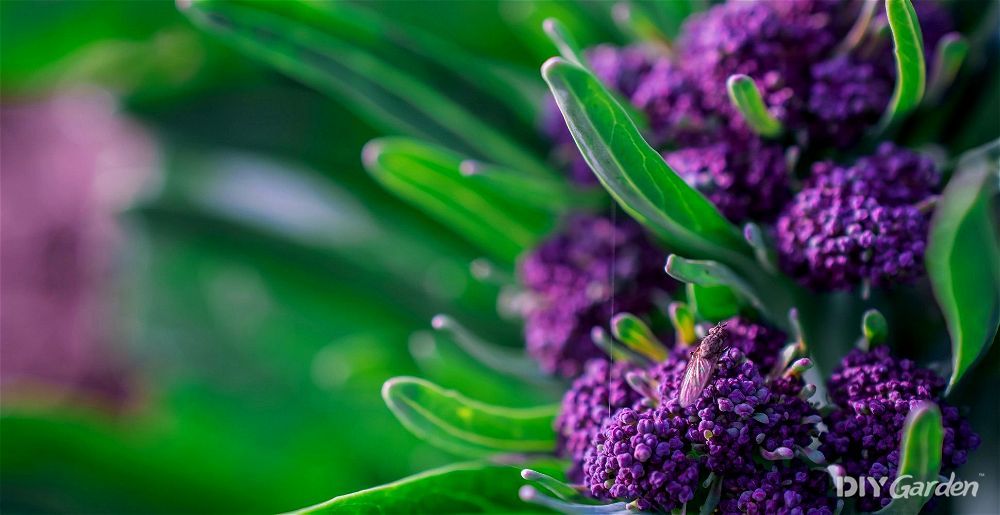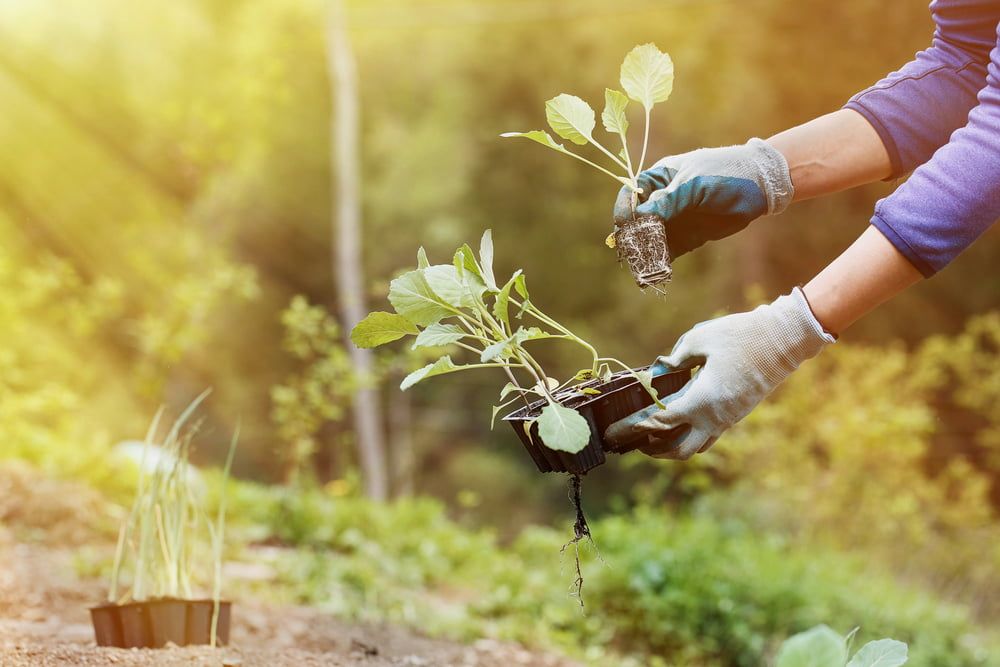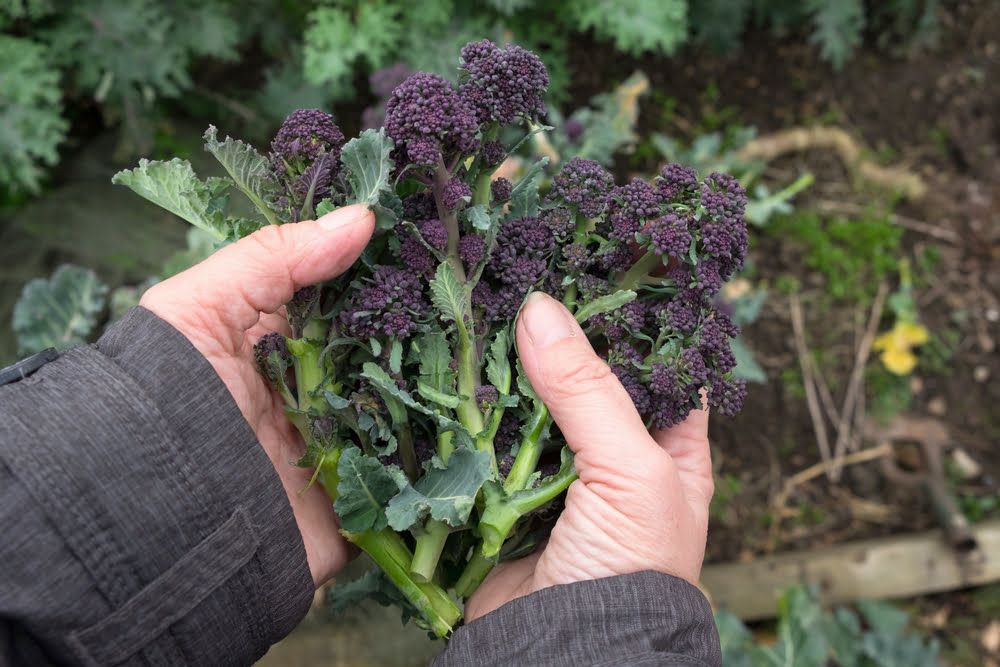
Purple sprouting broccoli is one of those vegetables that’s always quite pricey in a supermarket. This means that, even though it may be absolutely delicious and packed with nutrients, most people don’t eat it on a regular basis. What they don’t know is that purple sprouting broccoli plants happen to be highly productive, and, if you sow your seeds at the right time, you could be harvesting those gorgeous purple heads almost year-round, making it well worth learning how to grow your own.
Growing Purple Sprouting Broccoli: A Quick Snapshot
When to Sow – Mar-Jun
When to Plant – Apr-Jul
When to Harvest – Sep-Apr
Average Yield per Plant – 300-350g
Spacing – 50-60cm
Depth – 2cm
How to Grow Purple Sprouting Broccoli at Home
Although usually grown as an biennual, many gardeners have had success establishing their purple sprouting broccoli plants as a perennial. This is surprisingly easy to do, requiring no more than providing the right growing conditions and never allowing the plants to fully flower.
Growing Requirements for Purple Sprouting Broccoli
Purple sprouting broccoli does best in full sun, although it will tolerate very light shade too. The plants aren’t afraid of the cold – they’ll survive temperatures down to -12°C.
Purple sprouting broccoli plants need to be in a site that’s protected from strong winds. They can end up quite lanky as they grow, and young plants could find themselves toppling over in bad weather. If an exposed location is your only option, then you’ll need to stake your plants.
Just like all other brassicas, purple sprouting broccoli thrives in alkaline soil. This also needs to be rich and moisture-retentive – heavier soils are great for holding those roots down.
How to Grow Purple Sprouting Broccoli from Seed
Although purple sprouting broccoli can be direct sown outside, the plants take about seven months to grow, and require quite a bit of space to do so. For this reason, most gardeners start their seeds off indoors at the beginning of the season, before sowing directly outside later in the year, once other vegetables have been harvested.
When to Sow Purple Sprouting Broccoli Seeds
For the longest harvesting period, aim to sow your purple sprouting broccoli seeds at least twice in the year. Your first sowing should be in March or early April. This will give you a harvest in the autumn, which will take you into the winter.
Your second sowing should be in early summer, ideally mid-June to July. As mentioned, this sowing can be done directly outside, and will give you a harvest early in the new year. Your plants should continue to produce until the end of spring.
How to Sow Purple Sprouting Broccoli Seeds
If you’re only planning on sowing a few seeds (aim for about two or three plants per person in your household), then start them in 7cm pots. However, if you plan on raising a larger number of seedlings, modular trays would be more convenient.
How to Sow Purple Sprouting Broccoli Seeds in Modules:
- Fill your pots with a multi-purpose compost, breaking up any lumps
- Water the compost well, making sure that excess water is draining freely from the bottom of each pot
- Use your finger to make small indentations in each module, about 1.5-2cm deep
- Place two seeds into each indentation and then cover back over with compost. Don’t firm the compost down
- Water lightly again and place in a warm location. Germination rates are best at temperatures between 21-27°C
Your purple sprouting broccoli seeds should germinate in one to two weeks. Give the seedlings a week or two to grow, before thinning out the weaker seedling in each pot.
How to Direct Sow Purple Sprouting Broccoli Seeds:
- Prepare your planting bed by incorporating plenty of organic material
- Create furrows in the soil that are about 2cm deep
- Sow your seeds thinly before covering over with soil
- Lightly water after sowing
Once your seeds germinate, give them a couple of weeks before thinning them down to about 15cm. Then, wait for a couple more weeks before thinning them down again, leaving 50-60cm between each plant. Although you could thin them to this spacing to begin with, leaving a few extra seedlings in gives you some insurance in case others succumb to pests, diseases, or bad weather.
You can either replant any thinned seedlings in another part of your garden, or eat them as microgreens – they’re full of nutrition!
How to Plant Purple Sprouting Broccoli Outside
Once your purple sprouting broccoli seedlings are about 8cm tall, they can be planted out.
Prepare your planting area by incorporating plenty of organic material. This will add nutrients while also improving the soil’s moisture retention.
Then, dig holes that are large enough to accommodate each seedling rootball, along with the rest of the soil in each pot. Space each hole 50-60cm apart to give each plant enough room to spread. Spacing is extremely important – as you’ll see below, the most common diseases that purple sprouting broccoli faces are caused by overcrowding and a lack of air circulation.
Gently squeeze your seedlings out of their pots and place them into their holes. Cover over and firm down well – purple sprouting broccoli needs the soil in its growing area to be quite firm and solid, yet not overly compacted. It’s a tricky balance!
Water well after planting.
How to Plant Purple Sprouting Broccoli in a Greenhouse
Since purple sprouting broccoli is extremely cold-hardy and develops into quite a large plant, most gardeners grow it outside. However, those who live in very cold regions may find it useful to grow their late winter crop in a greenhouse in order to give the plants some extra protection. To do this, follow the same planting methods as when planting outside.
If you don’t have enough space in your greenhouse beds, try planting your purple sprouting broccoli in pots. This way, you can keep them outdoors in the summer, when your greenhouse is busy growing other vegetables, before moving them into your greenhouse in the autumn.
Purple sprouting broccoli does well in pots, so long as the container you choose is large enough. Aim for a pot that’s at least 30cm in both diameter and depth.
How to Care for Purple Sprouting Broccoli
Purple sprouting broccoli is an easy plant to care for. Its needs are pretty basic, yet it will reward you with delicious florets for several months.
Watering Purple Sprouting Broccoli
Purple sprouting broccoli is quite a thirsty plant. However, since it matures during the cooler months of the year, rainfall is usually enough to keep the soil moist.
That being said, you’ll still need to water your plants if you experience a dry spell.
Feeding Purple Sprouting Broccoli
Since purple sprouting broccoli is quite a heavy feeder, a couple of fertiliser applications during its growing season can help to increase yields.
Use a nitrogen-rich fertiliser during the earlier stages of growth, before switching to a general-purpose fertiliser as the plants mature.
Weeding and Mulching Purple Sprouting Broccoli
Weeds can seriously stunt the growth of purple sprouting broccoli plants, so keep their growing area as weed-free as possible.
Very few people actually enjoy weeding, so consider applying a mulch around your plants to cut back on the amount of weeding you’ll need to do. In addition to suppressing weeds, an organic mulch will help to retain moisture while providing an extra source of nutrients for your plants. It will also keep the soil cooler in the summer but warmer in the winter, which will encourage your plants to remain productive for longer.
How to Harvest Purple Sprouting Broccoli
It takes about seven months from germination for purple sprouting broccoli to be ready for harvesting. At this point, you’ll notice the purple spears beginning to emerge from the plant. You will see one larger and fatter spear at the centre of the plant, surrounded by smaller shoots around the sides.
Make sure that you harvest the central broccoli head first, before the flowers open up. This will then encourage the plant to produce even more side shoots, and these are what you’ll be harvesting for the rest of the season.
To harvest the shoots, use a sharp knife to cut their stem about 15cm down from the head. Make sure that you harvest the shoots before the flowers open up, even if you don’t plan on eating them straight away. If you allow your plants to flower, they’ll soon die off, ending your harvesting period.
How to Store Purple Sprouting Broccoli
Although it’s best eaten fresh, you can store your purple sprouting broccoli harvest in the fridge for two or three days. Simply place the spears into an airtight bag.
Freezing your harvest is another option, although this severely compromises texture. If you want to give freezing a try, you’ll need to blanch the shoots first. Then, lay them out on a tray and place them into the freezer. Once frozen, place all of the shoots into an airtight bag and store in the freezer for up to six months.
How to Prepare & Cook Purple Sprouting Broccoli
The leaves, stalks, and florets of purple sprouting broccoli stems are edible (and delicious!). However, older leaves and stem parts can be quite tough and woody, so these are best trimmed off. Remove any wilting leaves too.
If you have any stems that are noticeably thicker than the rest, cut these up so that everything is a more uniform size. This will ensure that they all cook in the same amount of time.
How to Cook with Purple Sprouting Broccoli
Purple sprouting broccoli can be used as a replacement for regular broccoli in just about any dish. Its unique sweetness and tender texture can be showcased in so many tasty ways. Give some of the following dishes a try:
- Boiled or steamed and then topped with a lemon butter
- Stir-fried with garlic and sesame
- Roasted in olive oil
- Char-grilled with a tahini dressing
- Baked into a tart or quiche with leeks and onions
- Eaten raw with a dip
Common Purple Sprouting Broccoli Problems
If you’ve grown other brassicas in the past, then you probably know that they can sometimes be plagued with problems. This depends a lot on your location, as well as the growing conditions in your garden.
If cabbage root fly and cabbage moth have been an issue for you in the past, then chances are that they’ll strike again. Take preventative measures by meshing your plants. This will also protect them from pigeon damage.
In terms of diseases, the main ones to look out for are:
- Leaf spot – this disease, which is prevalent in humid conditions, starts off as small black spots that slowly enlarge, with the rest of the leaf turning yellow. Remove any infected plant parts and try to improve air circulation around your plants. A mulch will also help to prevent water from splashing up onto foliage
- Downy mildew – this disease first shows as light green spots that soon turn brown and join up to form large patches. You’ll also notice a fuzzy mould on the undersides of leaves. The disease thrives in damp conditions. Remove affected leaves and improve air circulation. Regular weeding helps too, as does watering at the base of your plants, rather than from above
Popular Purple Sprouting Broccoli Varieties to Grow
There are several purple sprouting broccoli varieties out there that are worth trying, but these are some of the best:
- Claret – extremely prolific and cold-hardy
- Burbank – produces beautiful creamy white shoots, but isn’t as cold-hardy as purple varieties
- Rudolph (pictured above) – large plants that produce large spears
- Summer Purple – this variety can be harvested earlier in the season, from July onwards
Conclusion
There aren’t many vegetables that can be harvested in the darkest days of the winter months, making purple sprouting broccoli such a valuable vegetable to grow at home. Rich in nutrients and incredibly versatile in the kitchen, it’s easy to see why this highly productive plant is quickly becoming a regular in so many gardens around the world.







